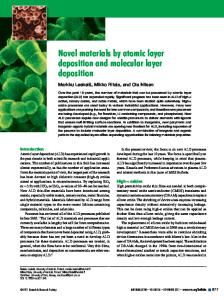Properties of ultrathin platinum deposited by atomic layer deposition for nanoscale copper-metallization schemes
- PDF / 249,589 Bytes
- 7 Pages / 585 x 783 pts Page_size
- 98 Downloads / 376 Views
A thermal metalorganic atomic layer deposition (ALD) process was developed for the in situ, sequential growth of Pt/TaNx stacks for use as barrier/seed stacks for subsequent copper electroplating. Ultrathin platinum films were deposited by alternating pulses of (methylcyclopentadienyl)trimethylplatinum (MeCpPtMe3) and oxygen (O2) as co-reactants. An ALD process window was established and optimized by investigating saturation of Pt film-growth rate versus MeCpPtMe3 and O2 exposure as controlled by the length of reactant pulses and the duration of the inert gas purge cycles separating the reactant pulses. The resulting low-temperature (300 °C) ALD Pt process yielded uniform and continuous Pt films with typical carbon and oxygen impurity levels around, respectively, 2.5 and 1 at.%. Film conformality was nearly 100% in 120-nm trench structures with 11:1 aspect ratio.
I. INTRODUCTION
Copper (Cu) interconnects have been successfully implemented in integrated circuitry (IC) ultralarge scale integration (ULSI) schemes to reduce the resistancecapacitance (RC) delay in signal-carrying metallization schemes. In this respect, Cu electrochemical deposition (ECD) has become the prevailing technique for filling sub-100-nm trenches and vias in the corresponding complex structures. However, Cu cannot be efficiently electroplated directly on the refractory metals and metal nitrides used as Cu diffusion barriers/adhesion promoters, such as tantalum nitride (TaNx). Instead, a seed layer is required to provide the electrical conductivity and surface activation characteristics necessary for successful electroplating.1–3 With the continuing scale down in minimum feature size,3 the use of physical vapor deposition (PVD) techniques to form the requisite seed and barrier cladding layers is projected to become problematic due to non-conformal deposition profiles, particularly at the 65-nm technology node and beyond. Atomic layer deposition (ALD) presents a viable alternative for depositing the “zero-thickness” (艋4 nm thick) barrier/ cladding layers required in such structures, due to its excellent conformality and thickness control.3–5 These ALD characteristics are critical as emerging interconnect
a)
Present address: IBM T.J. Watson Research Center, Yorktown Heights, New York 10598 b) Address all correspondence to this author. e-mail: [email protected] DOI: 10.1557/JMR.2007.0152 1292 J. Mater. Res., Vol. 22, No. 5, May 2007 http://journals.cambridge.org Downloaded: 30 Nov 2014
technologies require zero-thickness seed and liner films in nanoscale device topographies. In contrast to conventional chemical-vapor-deposition (CVD) techniques, ALD chemical reactants are supplied in an alternating rather than concurrent fashion. The resulting reactions are non-pyrolytic: they typically occur below the decomposition temperatures of the chemical sources used. A standard ALD run involves a number of identical reaction cycles. For each cycle, the substrate surface is alternately exposed to the individual chemical reactants, with each ex
Data Loading...











